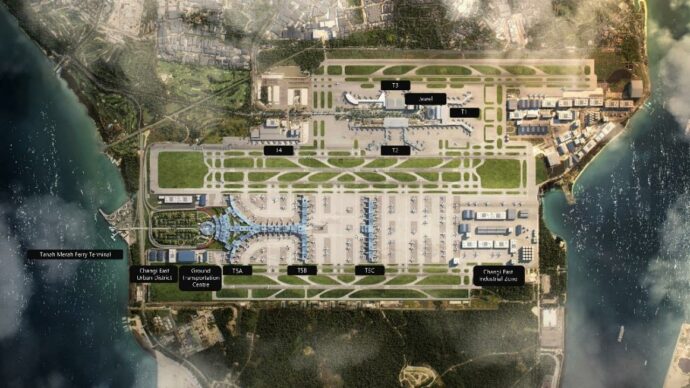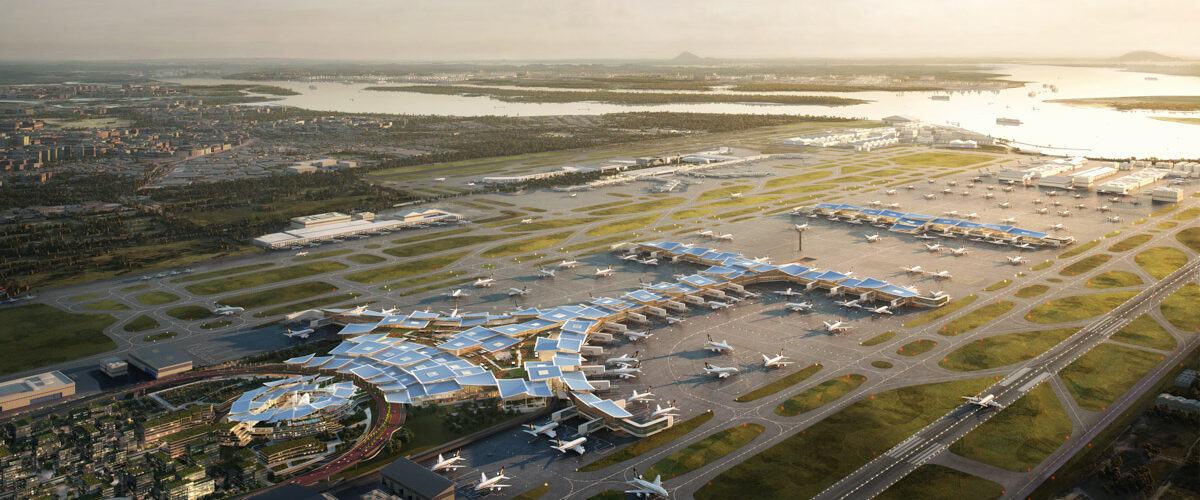
Prime Minister Lee Hsien Loong unveiled the plans and status of the development of Changi Airport Terminal 5 last night at the National Day Rally. Changi Airport Terminal 5 (T5) was first announced in 2013. Due to the Covid-19 pandemic, the T5 project was halted for two years.
During this time Singapore’s Ministry of Transport, Civil Aviation Authority of Singapore and Changi Airport Group re-assessed the trajectory of aviation growth, and reviewed the new terminal’s design to make it more modular, and to enhance its resilience and sustainability. Drawing on lessons learnt from the Covid-19 pandemic, T5 will be designed with the flexibility to operate as smaller sub-terminals when needed. Spaces could be converted for use during contingencies, such as for testing operations or the segregation of high-risk passengers.
Work on T5 Project Resumed
To secure Singapore’s capacity to ride on the long-term growth of aviation, work on the T5 project has resumed. CAG is re-mobilising the design and engineering consultants to refine the T5 design. Construction is expected to commence in about two years. T5 is scheduled to be operational around mid-2030s. T5 will be located within the 1,080-hectare Changi East development that is almost as big as the land area of Changi Airport today. It will be able to handle about 50 million passengers each year. T5 will be designed with the flexibility to be built in two phases, in line with traffic growth. This additional capacity will strengthen Changi Airport’s position as a premier air hub for the region and beyond.
Green and Sustainable
The new terminal will be a Green Mark Platinum Super Low Energy Building as certified by the Building and Construction Authority. Solar panels, smart building management systems, and district cooling combined with thermal energy storage will be deployed in the terminal building. T5 will also be ready for viable alternative fuels including the use of Sustainable Aviation Fuel, and for the provision of fixed ground power and cooling for aircraft parked at the gates.
Technology and Automation
T5 will leverage technology to automate and digitalise airport operations. T5 could see the deployment of autonomous vehicles to support baggage and cargo transport on the airside, as well as robotics for baggage handling. The terminal will be designed to accommodate and facilitate the deployment of such technology at scale.
Well-connected to rest of Singapore
T5 will be well-connected to the rest of Singapore, with a dedicated ground transportation centre where passengers can access rail, bus, and other point-to-point transport services.
Located at the doorstep of T5, the Changi East Urban District (CEUD) will create new spaces for Singaporeans to connect, work and play. Master-planning for the development of the CEUD will be done in consultation with the Ministry of National Development, the Urban Redevelopment Authority and other agencies.
T5 Development Timeline
| 2013 | PM spoke about the plans for T5 and Changi East in his National Day Rally speech. Shortly after, the Changi 2036 Steering Committee, which was established to develop a holistic long-term plan for the expansion of Changi Airport, announced its recommendations to construct T5 and implement a three-runway system at Changi. |
| 2014 | Land preparation works for Changi East and planning for T5 began in 2014, including functional design studies and concept development for the terminal. |
| 2018 | CAG announced the appointment of the Master Building Consultants (MBC) in 2018, to provide architectural design and engineering consultancy services for the development of T5. The Master Civil Consultants (MCC) were also appointed, to provide consultancy services for the design of infrastructure at the landside and airside areas outside of the T5 buildings. |
| 2020 | A two-year pause of the T5 project was announced in 2020, due to the Covid-19 pandemic. The aim was to assess the impact of Covid-19 on aviation growth, learn from the pandemic experience, and review T5’s design to meet the needs of post-pandemic travel. |
| 2022 | The resumption of work on the T5 project was announced in 2022. MOT, CAAS and CAG had taken the opportunity of the two-year pause to comprehensively review the T5 design to make it more modular, resilient and sustainable. Construction of T5 will commence in about two years for T5 to meet the anticipated demand for air travel around the mid-2030s. |





Pingback: British Airways adds a second daily flight from Changi Airport to London Heathrow | SUPERADRIANME.com